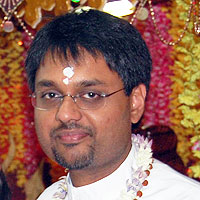From a satsang with Pt. Dr. Umesh Persad, Spiritual Leader, SWAHA Gyaan Deepak Kirtan Mandali
The life of Shree Raam is a reflection of our own journey through life. He confronted many situations that are similar to the circumstances that we ourselves might face. Thus, his reactions and decisions are applicable in many ways to our own lives. In Ayodhya Kaand of the Shree Raamcharitamaanas, just as Shree Raam is about to be coronated, Queen Kaikeyi, who had received two boons from King Dasrath, asked that he exile Shree Raam to the forest and instead, install her son, Bharath as king of Ayodhya. It is instructive to analyze Shree Raam’s reaction on being informed that he must live in exile in the forest outside Ayodhya for 14 years:
“While men and women alike were thus overwhelmed with excessive grief, the holy Lord Raam called on his mother, Kaushalya, with joy in His face and fourfold exultation in His heart. He feared no more that the king might detain Him.”
“Raghubeer’s mind had been like a young elephant, newly caught with kingship. When He heard of his banishment to the forest, He knew that He was freed, and felt overjoyed in His heart.”
Shree Raam was replaced as king and exiled, and yet He still retained a peaceful look of happiness on his face and in His heart. The inhabitants of Ayodhya, on the other hand, had expectations that Shree Raam would become king and were beset with grief. Everyone but Shree Raam was depressed and disappointed. The moral is that any expectation we have can lead to pain and sorrow. At some time, in everyone’s life, we are confronted by dashed expectations. Eastern philosophy teaches that we set ourselves up for disappointment if we have high expectations of the world, of people and things. The strategy is to reduce any expectation that anything in the outer world will bring inner joy. We must realize that peace is not a state to be gained afresh from the world; it is a quality that is always present.
The next step for Shree Raam was to visit his mother, Kaushalya. Kaushalya means satwa, purity, right thinking and, at a deeper level, skillfulness. Like Shree Raam, we might visit our mothers for advice or consolation during difficult situations. In the case where one no longer has a mother, the Guru can also serve as a guide in life. In this instance, the “fourfold exultation” that Shree Raam experienced in His heart must be further analyzed in terms of our own lives. In order to reach such a state in our own reactions to situations, we must strive for a life of meaning and purpose rather than a life of happiness, as life continually fluctuates between situations that bring us happiness and sadness.
There are several lenses through which we can apply the fourfold exultation of Shree Raam to our own lives. Firstly, there are four questions which we must answer in order to find the purpose of our existence:
- What do you love to do?
- What are you good at?
- What does the world need? That is, what skills that you love to do and are good at are in high demand?
- What can you get paid for?
In the past, children would follow in their parents’ footsteps. Nowadays, with the possibilities advanced by education, people can choose their own vocation. That sense of purpose in our life must stay with us beyond the western concept of retirement, into old age and until the day of death. It will take us closer to reaching that state of exultation of heart. Shree Raam’s true purpose in life, as an avataar, was much larger than being coronated as king of Ayodhya.
Secondly, in Sanaatan Dharma, it is said, we seek four things: dharma (righteousness), artha (material wealth), kaama (legitimate desires) and moksha (liberation). Shree Raam was going into exile to fulfil his father’s word. His decision was based on righteous values. He was leaving the kingdom with all its riches to go to the forest. Yet, He was peaceful, because material things such as wealth, leadership and power do not necessarily make us happy. Liberation means being in the world of activity but not being affected by it. Shree Raam’s mind was liberated. For us to be happy as well, the importance of artha and kaama should be de-emphasized as life goals and dharma and moksha should be emphasized, especially as we grow older in life.
We can analyze this incident from yet another perspective: In the past, Shree Raam had been tutored by his Guru, Sage Vasistha, which is documented in the scripture, Yoga Vasistha. The sage taught Shree Raam that there are four guards to the gates of liberation: peace of mind, self-enquiry, contentment and association with holy ones. In the forest, Shree Raam would have peace of mind. He would then have time for self-enquiry. He would be content with very little and he would meet many holy persons in the forest.
Thus, by discovering and living a life of purpose; valuing the main goals of life, particularly righteous living and liberation; and befriending the guards to the gate of liberation, we too can experience joy and exultation of heart.



